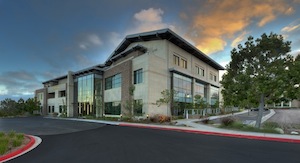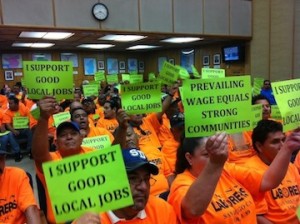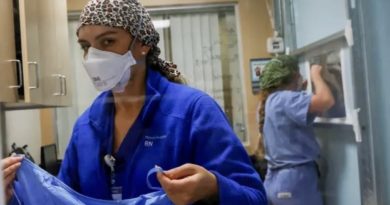Daily Business Report-Sept. 20, 2013
Deck of the San Diego Convention Center
Chargers and Mayor’s Office Meet Over
Stadium and Convention Center Plans
Interim Mayor Todd Gloria said he had a positive 30-minute meeting this week with the Chargers executive who is spearheading the NFL team’s efforts to build a new stadium. “I thought we actually had a positive conversation about what we could do collaboratively to make sure to make sure that we keep the Chargers in San Diego,” Gloria said at his weekly media briefing. “I’m certainly committed to doing that. The city is committed to that.” The Monday meeting with Mark Fabiani came a couple of weeks after the Chargers proposed to the California Coastal Commission an alternative to the city’s plan to expand the San Diego Convention Center.
The city plan would have all of the expansion on the current site and give the center the largest amount of contiguous floor space on the West Coast. The Chargers’ proposal would limit the expansion at the convention center location but would add a new stadium a few blocks away that could also provide space for major gatherings. The city’s plan goes before the Coastal Commission next month for its final regulatory hurdle. The financing mechanism is being challenged in court.
Fabiani told City News Service that the team’s alternative will come in handy if the city plan is rejected by the commission or loses in court. “We put our idea out there,” Fabiani said. “It’s an alternative that hopefully the city will consider if needed.” He also characterized the meeting as positive.
County Unemployment Rate Drops
Nonfarm employment up 2,900 jobs over the month and up 14,800 jobs over the year
San Diego County’s unemployment rate dropped to 7.4 percent in August — down from 7.8 percent in July and below the year-ago estimate of 9.2 percent, the state Employment Development Department reported today. California’s jobless rate for the same period was 8.8 percent. The national jobless rate was 7.3 percent.
Between July and August:
Total nonfarm employment increased from 1,274,900 to 1,277,800, a gain of 2,900 jobs. Agricultural employment declined by 100 jobs, or 1.0 percent
• Leisure and hospitality reported the greatest month-over gain, adding 3,300 jobs. Accommodation and food services (up 3,100) accounted for more than 90 percent of the job growth in this sector, mostly from food service and drinking places (up 2,900). Arts, entertainment, and recreation added 200 jobs.
• Five other industries also added jobs over the month: Government (up 1,000); professional and business services (up 900); educational and health services (up 700); trade, transportation, and utilities (up 500); and other services (up 100).
• Three nonfarm sectors recorded month-over job losses. The most notable declines came from construction (down 1,800), primarily from specialty trade contractors (down 1,400), and financial activities (down 1,700).
Between August 2012 and August 2013:
Total nonfarm employment increased by 14,800 jobs, or 1.2 percent. Agricultural employment declined by 100 jobs, or 1.0 percent.
• Educational and health services posted the greatest year-over gain, adding 5,300 jobs. Health care and social assistance (up 4,200) contributed to more than three-fourths of the job growth in this sector, mostly from ambulatory health care services (up 2,500). Educational services added 1,100 jobs.
• Six other sectors also added jobs over the year. The most significant gains came from leisure and hospitality (up 4,700); professional and business services (up 4,400); and trade, transportation, and utilities (up 3,400).
• Three nonfarm sectors recorded year-over job losses. The most notable declines came from manufacturing (down 2,800) and financial activities (down 1,200).
San Diego Home Prices Likely to Remain High
San Diego County remains one of the least affordable housing markets in the United States and a new report finds the situation may be around for some time, KPBS reports. The National University System Institute for Policy Research study examined two decades worth of housing data in the San Diego region. One key measurement weighed the median household income against the median home price. Nationally, the price of a home is about three times a person’s yearly income. In San Diego, the price of a home is more than five times annual pay. During the housing bubble, home prices peaked at eight times the region’s median household income. Researchers said there are a lot of reasons why home prices are high in San Diego and one big one is supply.
“We have some constraints based on our geography, but it’s also part of our policy of housing,” said Kelly Cunningham, an institute economist. “We restrict or limit the amount of housing that can be built or developed and this has the effect of constraining the supply.” Cunningham said there is no reason to think San Diego’s income-to-home-price ratio will shrink much over time, because even in the depth of the recession, the ratio was higher here than what’s considered normal for the rest of the country.

Kilroy Realty Purchases The Heights for $126 Million
Kilroy Realty Corp. has completed the purchase of a 13.8 acre Class A office development in the Del Mar area for $126 million. Known as The Heights, the development includes a three-story office building, a three-story life science building, which together total 219,000 square feet, and a subterranean parking structure. The development also includes a land site that is fully entitled for a 90,000-square-foot office building to be LEED certified. The two existing buildings, built in 2004, are fully leased to five tenants, including Neurocrine Bioscience and Knobbe Martens Olson & Bear. Amenities include a sports court, on-site fitness center and anamphitheater.
Verenium Corp. to be Acquired by BASF Corp.
Verenium Corp. a San Diego industrial biotechnology company focused on the development and commercialization of high-performance enzymes, has agreed to merge with BASF Corp., a chemicals company. BASF said it would offer Verenium’s shareholders $4 per share of common stock in cash.
Analysis: Economic Recovery Misses Most Households and Employees in San Diego Region
Economic recovery has bypassed most households in San Diego County, according to an analysis by the Center on Policy Initiatives of 2012 U.S. Census Bureau data. A growing number of people in the region — including many who are employed — remained mired in poverty five years after the recession began. More children have slipped into poverty. And middle-class families have lost buying power as median household income across the county continued to drop.
“People have less money to spend, even those working full-time,” said CPI Research Director Peter Brownell. “The wealthiest saw their incomes increase in 2012, but when we hear talk of economic recovery, it hasn’t reached most people in our region.”

Key Findings:
While the top-earning 20 percemt of households took in half of all income in the region, real median income for all households fell by $1,231 from the previous year.
More than a quarter (28.4 percent) of all individuals working full-time, year-round earned less than $30,000, roughly the amount needed for a single person to live self-sufficiently in San Diego County. More than 123,000 full-time or part-time employees fell below the federal poverty level ($11,945 a year for an individual).
The poverty rate in the county was virtually unchanged at 15 percent (from 15.1 percent in 2011), much higher than the pre-recession level of 11.1 percent. The rate of children living in poverty jumped to 19.8 percent.
Besides children, groups hit hardest by poverty — with rates of 20 percent or higher — included African Americans, Latinos, and the cities of El Cajon, San Marcos and Escondido.
More than 1 million San Diego County residents, a third of the population, lived in economic hardship, at or below double the poverty rate. That measure is used because the federal poverty level, which varies by family size, is unrealistically low compared to costs of living.
“Clearly, the economy can’t recover for most people until wages are high enough that our neighbors can support themselves and spend money in the local community,” Brownell said. “Poverty and low wages drag down the entire region, as these data show. The recent vote to increase California’s minimum wage to $10 an hour is a welcome first step, but too little and too slow.”
Kleinfelder to Move Corporate HQ to Downtown
Kleinfelder, an architecture engineering and science consulting firm, has signed a long-term lease for 43,000 square feet of space at the 550 Corporate Center Building in Downtown San Diego, intending to move from Kearny Mesa in March of next year. “Our new corporate headquarters in Downtown San Diego are a fundamental element of our business strategy,” said Bill Siegel, president and CEO. Kris Michell, president and CEO of the Downtown San Diego Partnership, said Kleinfelder’s relocation Downtown is proof that her organization’s business attraction efforts are gaining traction with San Diego’s most influential companies.
National University System Chancellor Retires
Jerry C. Lee, chancellor of the National University System since 2001 and who previously served as president of National University from 1989 to 2007, has officially retired. “The success of National University and the National University System under Dr. Lee is truly one of the remarkable achievements in higher education over the past 24 years,” said Herb Meistrich, chair of the National University System Board of Trustees. “We are looking forward to building upon the wonderful foundation he has established.” The board is expected to announce a new chancellor at its October meeting. Until a new chancellor is selected, the president of National University, Michael Cunningham, has assumed leadership of the National University System.
Housing Federation to Hold Annual Conference Oct. 2-3
The San Diego Housing Federation will host its 22nd annual Affordable Housing and Community Development Conference on Oct. 2-3 at the Market Creek Events and Venues. The keynote address will be delivered on Oct. 3 by Manuel Pastor, a nationally renowned thought-leader on demographic change, social movements and the economy and director of USC’s Program for Environmental and Regional Equity. The conference attracts nearly 400 housing and community development leaders and experts from across the county and state.
Cyber Security Summit to be Held Sept. 24
To kick off Cyber Security Awareness Month in October, San Diego City Council President Pro Tem Sherri Lightner is hosting a summit intended to link government, education, military and business leaders together with other industry experts to discuss how to support and grow the region’s fledgling cyber security sector. The Cyber Security Summit will be held Tuesday, Sept. 24, from 9 to 11 a.m. at the Lodge at Torrey Pines. Panelists will include: Congresswoman Susan Davis; Sean Barr, vice president of San Diego Regional Economic Development Corp.; Ret. Vice Adm. Walter Davis, vice president of CommNexus; Liz Fraumann, executive director of Securing Our eCity Foundation; Barry Janov, director with San Diego State University Research Foundation; Anthony Nufer, San Diego Military Advisory Council; and Patrick Sullivan; executive director of SPAWAR. For more information,contact San Diego City Council District 1 at (619) 236-6611.
Drone University Releases U.S. Drone Census
Drone University — a project of the New America Foundation — has created a map of drone users, researchers and lobbying groups driving the future of unmanned aerial vehicles in the United States, KPBS reports. You can filter the map by the type of stakeholder and zoom in on your neck of the woods. In the Southwest, the biggest concentration of drone stakeholders is (not surprisingly) around San Diego. San Diego is home to General Atomics, the main supplier of Customs and Border Protection’s fleet of drones. General Atomics also sells Predator drones to the U.S. military to carry out strikes against suspected terrorists in Pakistan and Yemen. The Senate immigration reform bill, passed in June, calls for more drones patrolling the U.S.-Mexico border. Southern California is also home to many major drone supporters in Congress, including Rep. Duncan Hunter (R-San Diego) and Rep. Buck McKeon (R-Rancho Cucamonga), co-chair of the Congressional Unmanned Systems Caucus.
The caucus — which lobbies for increased support for drones at the federal level — has a strong presence throughout the Southwest. The New America Foundation drone map also shows all the institutions that have applied for or received permission to fly drones under a provisional program run by the Federal Aviation Administration. The FAA is set to open up the skies to more drones in the near future. The map also shows drone legislation proposed and enacted in different states.

UC San Diego Research Scientist Teams With Top Coder and NASA for Coding Challenge
A crowdsourcing effort led by UC San Diego research scientist Albert Yu-Min Lin has turned into a new type of challenge — inviting programmers worldwide to develop a machine-learning algorithm that would match human perception when picking out interesting features in satellite imagery used in Lin’s search for the lost burial site of Genghis Khan. TopCoder Inc., the world’s largest open innovation platform and competitive community of digital creators, announced the new challenge through the NASA Tournament Lab, in partnership with Lin, who works in Calit2’s Qualcomm Institute at UC San Diego and who is also a National Geographic Emerging Explorer. Lin is a three-time alumnus of UCSD’s Jacobs School of Engineering in electrical engineering and materials science.
Lin applied the concept of crowdsourcing to an ambitious satellite imagery labeling initiative. In the first-of-its-kind collective exploration experiment, tens of thousands of amateur analysts worldwide helped Lin’s team at UC San Diego identify sites of cultural and historical significance. “Here we turn towards the crowd not only to tackle the data size challenge of large-scale satellite remote sensing, but more importantly to pool human perception and intuition when sifting through the data for anything that looks ‘out of the ordinary,’” said Lin. His team then mounted a series of land expeditions to verify regions of high interest defined by the crowd.
To respect the traditional beliefs of indigenous people, Lin and his team have used state-of-the-art technologies to conduct a noninvasive survey of Genghis Khan’s homeland. The quest to find Genghis Khan’s tomb has mystified scientists for hundreds of years.



